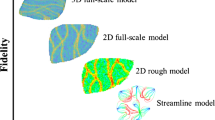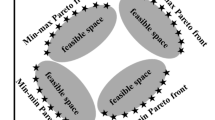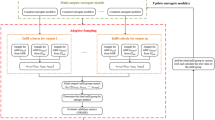Abstract
Recently, many researchers have focused on reservoir production optimization because it is one of the most essential processes in closed-loop reservoir management. Surrogate-assisted production optimization in particular has received a lot of research attention. This technique applies a simple yet vigorous approximation model to substitute expensive numerical simulation runs. However, almost all the existing methods independently use a single approximation model and neglect the potential synergies between these models. In order to make full use of the potential synergies of these existing approximation models, a novel multi-fidelity (MF) surrogate-assisted multi-objective production optimization (MOPO) method based on transfer stacking (MFTS-MOPO) is proposed. In the MFTS-MOPO method, the radial basis function network and support vector regression surrogate models are applied to approximate the high-fidelity (HF) model as the two additional low-fidelity (LF) models. Then a multi-fidelity surrogate model is adopted to evaluate objectives during the optimization process by transferring the two additional and streamline low-fidelity models to the computationally expensive high-fidelity model. Furthermore, two sampling infill strategies are applied to efficiently improve the quality of the multi-fidelity surrogate model. The uniqueness of the proposed MFTS-MOPO method is that the transfer stacking technique is employed to efficiently use the information from different fidelity models to establish the MF surrogate model and the infill sampling strategy used to improve its performance. In addition, three benchmark problems and two reservoirs with different scales were applied to illustrate the effectiveness and accuracy of the MFTS-MOPO method. It was found that the MFTS-MOPO method had superior performance in convergence and diversity than other conventional methods.
Similar content being viewed by others
References
Basso, G.L., Rosa, F., Garcia, D.A., et al.: Hybrid systems adoption for lowering historic buildings PFEC (primary fossil energy consumption)-a comparative energy analysis[J]. Renew. Energy. 117, 414–433 (2018)
Feng, D., Li, X., Wang, X., Li, J., Sun, F., Sun, Z., Zhang, T., Li, P., Chen, Y., Zhang, X.: Water adsorption and its impact on the pore structure characteristics of shale clay[J]. Appl. Clay Sci. 155, 126–138 (2018)
Hunt, N.D., Liebman, M., Thakrar, S.K., Hill, J.D.: Fossil energy use, climate change impacts, and air quality-related human health damages of conventional and diversified cropping systems in Iowa, USA[J]. Environ. Sci. Technol. 54(18), 11002–11014 (2020)
Umar, M., Ji, X., Kirikkaleli, D., Alola, A.A.: The imperativeness of environmental quality in the United States transportation sector amidst biomass-fossil energy consumption and growth[J]. J. Clean. Prod. 285, 124863 (2021)
IEA (2020), Global Energy Review 2020, IEA, Paris https//www.iea.org/reports/global-energy-review-2020
Ding, S., Lu, R., Xi, Y., Liu, G., Ma, J.: Efficient well placement optimization coupling hybrid objective function with particle swarm optimization algorithm[J]. Appl. Soft Comput. 95, 106511 (2020)
Guo, Z., Reynolds, A.C.: Robust life-cycle production optimization with a support-vector-regression proxy. SPE J. 23(06), 2409–2427 (2018)
Isebor, O.J., Durlofsky, L.J.: Biobjective optimization for general oil field development. J. Petrol. Sci. Eng. 119, 123–138 (2014)
Wang, L., Li, Z.P., Adenutsi, C.D., Zhang, L., Lai, F.P., Wang, K.J.: A novel multi-objective optimization method for well control parameters based on PSO-LSSVR proxy model and NSGA-II algorithm[J]. J. Pet. Sci. Eng. 196, 107694 (2020)
Zhang, L., Li, Z., Lai, F., Li, H., Adenutsi, C.D., Wang, K.J., Yang, S., Xu, W.L.: Integrated optimization design for horizontal well placement and fracturing in tight oil reservoirs. J. Pet. Sci. Eng. 178, 82–96 (2019)
Zhao, M., Zhang, K., Chen, G., et al.: A surrogate-assisted multi-objective evolutionary algorithm with dimension-reduction for production Optimization. J. Pet. Sci. Eng. 192(September), 107192 (2020a). https://doi.org/10.1016/i.petrol.2020.107192
Ding, S., Lu, R., Xi, Y., Yue, J., Liu, G., Reynolds, A.C., Yu, H.: Optimizing vertical and deviated wells based on advanced initialization using new productivity potential map[J]. J. Pet. Sci. Eng. 198, 108263 (2021)
Guo, Z., Reynolds, A.C., Zhao, H.: Waterflooding optimization with the INSIM-FT data-driven model. Comput. Geosci. 22(3), 745–761 (2018a)
Zhao, M., Zhang, K., Chen, G., et al.: A Classification-Based Surrogate-Assisted Multiobjective Evolutionary Algorithm for Production Optimization Under Geological Uncertainty. SPE J. 25(5), 2450–2469. SPE-201229-PA (2020b). https://doi.org/10.2118/201229-PA
Liu, Z., Reynolds, A.: Robust multiobjective nonlinear constrained optimization with ensemble stochastic gradient sequential quadratic programming-filter algorithm[J]. SPE J. 26, 1–16 (2021)
Feng X, He R, Chen Z. Superconvergence in H1-norm of a difference finite element method for the heat equation in a 3D spatial domain with almost-uniform mesh[J]. Numerical Algorithms, 86(1), 357–395 (2021)
Chen, Y., Oliver, D.S.: Ensemble-based closed-loop optimization applied to Brugge field[J]. SPE Reserv. Eval. Eng. 13(1), 56–71 (2010)
Liu, X., Reynolds, A.: Gradient-based multiobjective optimization for maximizing expectation and minimizing uncertainty or risk with application to optimal well-control problem with only bound constraints. SPE J. 21(5), 1813–1829 (2016)
Zhang, K., Zhang, L.M., Yao, J., et al.: Water flooding optimization with adjoint model under control constraints[J]. Journal of hydrodynamics. Ser. B. 26(1), 75–85 (2014)
Chen Y, Oliver D S, Zhang D: Efficient Ensemble-Based Closed-Loop Production Optimization. In: Paper Presented at the SPE Symposium on Improved Oil Recovery, Tulsa, Oklahoma, USA (2009) https://doi.org/10.2118/112873-MS
Fonseca, R., Leeuwenburgh, O., Rossa, E.D., et al.: Ensemble-based multiobjective optimization of on/off control devices under geological uncertainty. SPE Res Eval & Eng. 18(4), 554–563 (2015)
Liu Z, Reynolds A: An SQP-filter algorithm with an improved stochastic gradient for robust life-cycle optimization problems with nonlinear constraints. Paper presented at the SPE reservoir simulation conference, Galveston, Texas, USA,10-11 April. SPE-193925-MS (2019)
Chang, Y., Bouzarkouna, Z., Devegowda, D.: Multi-objective optimization for rapid and robust optimal oilfield development under geological uncertainty. Comput. Geosci. 19(4), 933–950 (2015)
Adl, A., Bing, X.B., Mz, B.: Multi-objective feature selection using hybridization of a genetic algorithm and direct multisearch for key quality characteristic selection[J]. Inf. Sci. 523, 245–265 (2020)
Zhang, L., Li, Z.P., Li, H., Adenutsi, C.D., Lai, F.P., Wang, K.J., Yang, S.: Application of polynomial Chaos expansion to optimize injection-production parameters under uncertainty[J]. Math. Probl. Eng. 2020, 1–13 (2020)
Chen, G., Zhang, K., Zhang, L., Xue, X., Ji, D., Yao, C., Yao, J., Yang, Y.: Global and local surrogate-model-assisted differential evolution for Waterflooding production optimization[J]. SPE J. 25(1), 105–118 (2020)
Rahmanifard, H., Plaksina, T.: Application of fast analytical approach and AI optimization techniques to hydraulic fracture stage placement in shale gas reservoirs[J]. Journal of Natural Gas Science and Engineering. 52, 367–378 (2018)
Rostamian, A., Jamshidi, S., Zirbes, E.: The development of a novel multi-objective optimization framework for non-vertical well placement based on a modified non-dominated sorting genetic algorithm-II. Comput. Geosci. 23(5), 1065–1085 (2019)
Wang L, Yao Y, Wang K, et al. 2021. A novel surrogate-assisted multi-objective optimization method for well control parameters based on tri-training[J]. Nat. Resour. Res., (2021)
Zhang H, Sheng J . Optimization of horizontal well fracturing in shale gas reservoir based on stimulated reservoir volume[J]. Journal of Petroleum Science and Engineering, 190, 107059 (2020).
Zhou, Y.S., Ong, M.H., Nguyen, D.: Lim, a study on polynomial regression and Gaussian process global surrogate model in hierarchical surrogate-assisted evolutionary algorithm, in:2005 IEEE congress on evolutionary Computation,3. IEEE, 2832–2839 (2005)
Liu, Y., Sun, W., Durlofsky, L.J.: A deep-learning-based geological parameterization for history matching complex models. Math. Geosci. 51, 725–766 (2019)
Rao, X., Zhao, H., Deng, Q.: Artificial-neural-network (ANN) based proxy model for performances forecast and inverse project design of water huff-n-puff technology[J]. J. Pet. Sci. Eng. 195, 107851 (2020)
Zhu, Y., Zabaras, N.: Bayesian deep convolutional encoder-decoder networks for surrogate modeling and uncertainty quantification. J. Comput. Phys. 366, 415–447 (2018)
Guo,Z., Chen,C., Gao,G., Vink,J: Enhancing the performance of the distributed gauss-Newton optimization method by reducing the effect of numerical noise and truncation error with support-vector regression. SPE Journal. 23(6), 2428–2443 (2018)
Nguyen, H., Bui, X.N., Choi, Y., Lee, C.W., Armaghani, D.J.: A novel combination of whale optimization algorithm and support vector machine with different kernel functions for prediction of blasting-induced Fly-rock in quarry mines[J]. Nat. Resour. Res. 30, 1–17 (2021)
Pan, S.J., Yang, Q.: A survey on transfer learning[J]. IEEE Trans. Knowl. Data Eng. 22(10), 1345–1359 (2009)
Desbordes, J.K., Zhang, K., Xue, X., Ma, X., Luo, Q., Huang, Z., Hai, S., Jun, Y.: Dynamic production optimization based on transfer learning algorithms[J]. J. Pet. Sci. Eng. 109278, 109278 (2021)
Klie, H., Yan, B., Klie, A.: Transfer learning for scalable optimization of unconventional field operations[C]//unconventional resources technology conference, 20–22. Unconventional Resources Technology Conference (URTEC). 2020, 2315–2333 (2020)
Yao, J., Nie, Y., Zhao, Z., Xue, X., Zhang, K., Yao, C., Zhang, L., Wang, J., Yang, Y.: Self-adaptive multifactorial evolutionary algorithm for multitasking production optimization[J]. J. Pet. Sci. Eng. 205, 108900 (2021)
Zhong, C., Zhang, K., Xue, X., Qi, J., Zhang, L., Yao, C., Yang, Y., Wang, J., Yao, J., Zhang, W.: Surrogate-reformulation-assisted multitasking knowledge transfer for production optimization[J]. J. Pet. Sci. Eng. 109486, 109486 (2021)
Forrester A I J, Sóbester A, Keane A J. Multi-fidelity optimization via surrogate modelling[J]. Proceedings of the royal society a: mathematical, physical and engineering sciences, 463: 3251–3269 (2007).
Leary, S.J., Bhaskar, A., Keane, A.J.: A knowledge-based approach to response surface modelling in multifidelity optimization[J]. J. Glob. Optim. 26(3), 297–319 (2003)
Peherstorfer, B., Willcox, K., Gunzburger, M.: Survey of multifidelity methods in uncertainty propagation, inference, and optimization[J]. SIAM Rev. 60(3), 550–591 (2018)
Crane, M., Bratvedt, F., Bratvedt, K. et al.: A fully compositional streamline simulator. Paper presented at the SPE annual technical conference and exhibition, Dallas, Texas, USA,1-4 October. SPE-63156-MS (2000) https://doi.org/10.2118/63156-MS.
Jansen, J.D., Durlofsky, L.J.: Use of reduced-order models in well control optimization. Optimiz. Eng. 18(1), 105–132 (2017)
Yin, F., Xue, X., Zhang, C., Zhang, K., et al.: Multifidelity genetic transfer: an efficient framework for production optimization. SPE J. (2021, 2021): SPE-205013-PA). https://doi.org/10.2118/205013-PA
Pardoe D, Stone P: Boosting for regression transfer, in: Proceedings of the 27th International Conference on International Conference on Machine Learning, Omnipress, pp. 863–870 (2010)
Drucker, H., Burges, C.J.C., Kaufman, L., et al.: Support vector regression machines[J]. Adv. Neural Inf. Proces. Syst. 9, 155–161 (1997)
Yu, H., Ying, T., Zeng, J., et al.: Surrogate-assisted hierarchical particle swarm optimization. Inf. Sci., 454–455 (2018). https://doi.org/10.1016/j.ins.2018.04.062
Tian, J., Tan, Y., Zeng, J., Sun, C., Jin, Y.: Multiobjective infill criterion driven Gaussian process-assisted particle swarm optimization of high-dimensional expensive problems[J]. IEEE Trans. Evol. Comput. 23(3), 459–472 (2018)
Wu, J., Azarm, S.: Metrics for quality assessment of a multiobjective design optimization solution set[J]. J. Mech. Des. 123(1), 18–25 (2001)
Deb, K., Pratap, A., Agarwal, S., Meyarivan, T.A.M.T.: A fast and elitist multiobjective genetic algorithm: NSGA-II. IEEE Trans. Evol. Comput. 6(2), 182–197 (2002)
Helton, J.C., Davis, F.J.: Latin hypercube sampling and the propagation of uncertainty in analyses of complex systems[J]. Reliability Engineering & System Safety. 81(1), 23–69 (2003)
Jansen, J.D, Fonseca, R.M., Kahrobaei, S. et al.2014. The egg model-a geological Ensemble for Reservoir Simulation. Geosci Data.J1(2): 192–195
Peters, L., Arts, R., Brouwer, G., et al.: Results of the Brugge benchmark study for flooding optimisation and history matching. SPE Res. Eval. Eng. 13(3), 391–405. SPE-119094-PA (2010). https://doi.org/10.2118/119094-PA
Acknowledgments
The authors would like to acknowledge financial support from the National Basic Research Program of China (2015CB250900).
Data availability statement
All data generated or analyzed during this study are included in this published article.
Author information
Authors and Affiliations
Corresponding authors
Ethics declarations
Conflicts of competing interests
The authors declare that they have no known competing financial interests or personal relationships that could have appeared to influence the work reported in this paper.
Additional information
Publisher’s note
Springer Nature remains neutral with regard to jurisdictional claims in published maps and institutional affiliations.
Rights and permissions
About this article
Cite this article
Wang, L., Yao, Y., Zhang, L. et al. An intelligent multi-fidelity surrogate-assisted multi-objective reservoir production optimization method based on transfer stacking. Comput Geosci 26, 1279–1295 (2022). https://doi.org/10.1007/s10596-022-10160-8
Received:
Accepted:
Published:
Issue Date:
DOI: https://doi.org/10.1007/s10596-022-10160-8




